中英对照初中英语教案模板版含全英内容
- 格式:doc
- 大小:20.82 KB
- 文档页数:1
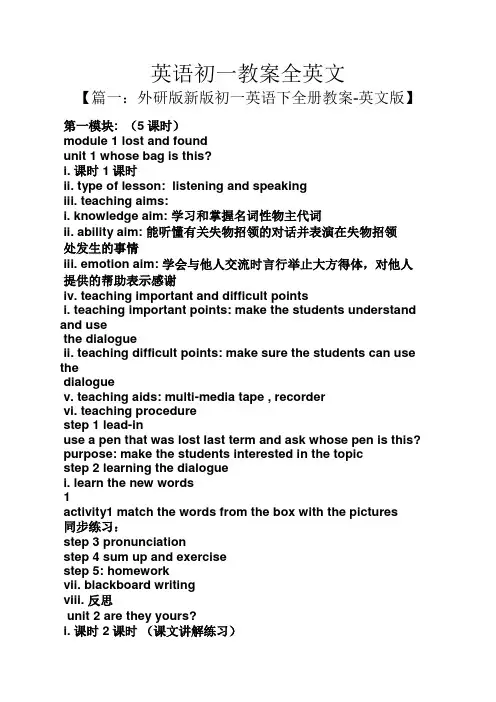
英语初一教案全英文【篇一:外研版新版初一英语下全册教案-英文版】第一模块: (5课时)module 1 lost and foundunit 1 whose bag is this?i. 课时 1课时ii. type of lesson: listening and speakingiii. teaching aims:i. knowledge aim: 学习和掌握名词性物主代词ii. ability aim: 能听懂有关失物招领的对话并表演在失物招领处发生的事情iii. emotion aim: 学会与他人交流时言行举止大方得体,对他人提供的帮助表示感谢iv. teaching important and difficult pointsi. teaching important points: make the students understand and usethe dialogueii. teaching difficult points: make sure the students can use thedialoguev. teaching aids: multi-media tape , recordervi. teaching procedurestep 1 lead-inuse a pen that was lost last term and ask whose pen is this? purpose: make the students interested in the topicstep 2 learning the dialoguei. learn the new words1activity1 match the words from the box with the pictures同步练习:step 3 pronunciationstep 4 sum up and exercisestep 5: homeworkvii. blackboard writingviii. 反思unit 2 are they yours?i. 课时 2课时(课文讲解练习)ii. type of lesson: reading and writingiii. teaching aims:iv. knowledge aim: 学习和掌握新单词v. ability aim: 能读懂有关失物招领的短文,能写出一则招领启事vi. emotion aim: 学会与他人交流时言行举止大方得体,对他人提供的帮助表示感谢iv. teaching important and difficult pointsi. teaching important points: make the students understand thepassageii. teaching difficult points: make sure the students can find someuseful information from the passage and write a lost and found note.2v. teaching aids: multi-media tape , recordervi. teaching procedurestep 1 pre-readinglearn the new words and show the students a lost and found note,lead in the passage.step 2 while-readingactivity 1: listen and read the passage.activity 2: read the passage and answer the questions.activity3: translate and explain the language pointsactivity 4: complete the passage with the correct form of the wordsand expressions from the box. (activity3 on p5)step 3 post-readingwriting (activity 4 on p5)step 4 sum up and exercisestep 5: homeworkvii. blackboard writingviii. 反思unit 3 language in usei. 课时 2课时(课本练习练习册)ii. type of lesson: grammariii. teaching aims:vii. knowledge aim: 名词性物主代词和形容词性物主代词的用法viii. ability aim: 能利用名词性物主代词和形容词性物主代词3解决一些问题ix. emotion aim: 学会与他人交流时言行举止大方得体,对他人提供的帮助表示感谢iv. teaching important and difficult pointsi. teaching important points: make the students solve somequestionsii. teaching difficult points: make sure the students do the exercisesv. teaching aids: multi-media tape , recordervi. teaching procedurestep 1: activity 1: work in pairs. ask and answer questions.the teacher prepare some school things, ask every pair to choose aschool thing, show the students a model, like this:--whose bag is this? is it yours?--no, it’s not mine. it’s his.give the students two minutes to make the dialogue, then present inthe class.activity 2: complete the sentences with the correct form of the words from the box.give the students three minutes to finish it themselves, then checkthe answers together.step 3: match the words from box a with the words from box b. this activity is very easy, so the students can do it together.step 4: around the world---the internet lost and found4ask the students read by themselves, then translate one by one, theteacher explain the language points.step 5: activity 4: work in pairs.the teacher prepares some things such as camera, crayons, football,gloves, mobile phone, wallet, watch and so on.student a: think of three or four things he/she has lost orhe/she canchoose from the box. describe them.student b: think of five or six things you have in your lost and found office or you can choose from the box. describe them.then ask and answer questions.student a: ask student b if they’ve got the things you have lost. answer questions about details.student b: answer questions about the things student a has lost.ask questions about details.give the students five minutes to prepare, then act out in the class.step 6: homeworkvii. blackboard writingunit 3 language in useviii. 反思5【篇二:全英文英语教案】teaching plan姓名学号班级科目:指导老师lesson 3 living abroadⅠ.background information:1. student: 45 senior high school students, grade 22. class duration: 45 minsⅡ.teaching aims:by the end of the lesson, students will be able to1. use the new words and phrases to express themselves;2. know the functions of present participle and make sentences with the grammar;3. find some cultural differences between chinese and american.Ⅲ.teaching contents:1. vocabulary and phrases that help to express culturaldifferences, such as embarrassed, embarrassing, exchange, host, hospitable, appetite, modest, stare at, have a difficult time doing sth. insist / keep on doing sth. notice / hear / see sb. doing sth.2. functions of present participle:⑴ hear sb. doing sth. (object complement)⑵ an embarrassing experience (attribute)⑶ what he did is amazing. (predicate)⑷ i went back to the room closing the door. (adverbial)3. some cultural differences between chinese and american in three different situations.Ⅳ.teaching aids: ppt, pictures, paper.Ⅴ.teaching procedures:step 1. lead- int: good morning, everyone!ss: good morning, teacher!step 2. learn the new words and phrasest: before the text, let us learn the new words. oh, the first two words are embarrassing. do not worry! now, we only need to recognize them. “embarrassed” means feeling shy and stupid, and we say sb. feel embarrassed. “embarrassing” refers to making sb. feel shy and stupid, and we say sth. is embarrassing. the subject is different, and you can compare them with “interested” and “interesting”. understand?ss: yes!t: ok! next, the word “change” means “交换”, while “exchange” refers to“交换或交流”. for example, “cultural exchange” means — (ask students to translate it.)ss: 文化交流.t: yes! then, when foreign friends come to china, we chinese, as the host or hostess, should be hospitable. (point at the ppt and say “friendly and generous”.) appetite---when the host or hostess is hospitable, the guest may feel delighted and have a good appetite (point at the ppt and say “desire for food”.) now, the last two words. (point at the ppt.) most chinese are modest. (point at the ppt and say “talking little about one’s own ability and achievement) “stare at” means looking at for a long time without moving. read after me —“embarrassed”.ss: embarrassed.(read after me: embarrassing, exchange, host, hospitable, appetite, modest, stare at)t: do you know how to use the new words in phrases? let us learn them together. (next ppt.) no strange words in the phrases, so we start directly. xxx, the meaning of the first one, please.student a: 度过一段困难时期t: yes, sit down please. this phrase is similar to “have difficulty doing sth.” xxx, the second one, please.student b: 有一次尴尬经历t: right! sit down, please. “look embarrassed” means “看起来尴尬”. and what about the fourth one?ss: 胃口好,有食欲.t: good! then, both “insist on” and “keep on” mean “继续”. the last one! “notice / hear / see + sb. + doing sth.” means “注意到/听到/看到+某人+正在做某事”. (show the sentences.) xxx, could you translate the sentences into chinese for us? student c: 我听见她正在唱歌和我听到过她唱歌。
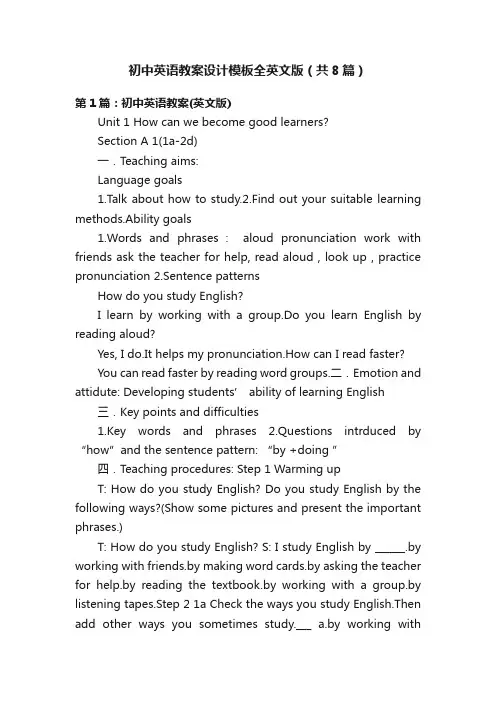
初中英语教案设计模板全英文版(共8篇)第1篇:初中英语教案(英文版)Unit 1 How can we become good learners?Section A 1(1a-2d)一.Teaching aims:Language goals1.Talk about how to study.2.Find out your suitable learning methods.Ability goals1.Words and phrases:aloud pronunciation work with friends ask the teacher for help, read aloud , look up , practice pronunciation2.Sentence patternsHow do you study English?I learn by working with a group.Do you learn English by reading aloud?Yes, I do.It helps my pronunciation.How can I read faster?You can read faster by reading word groups.二.Emotion and attidute: Developing students’ ability of learning English 三.Key points and difficulties1.Key words and phrases2.Questions intrduced by “how”and the sentence pattern: “by +doing ”四.Teaching procedures: Step 1 Warming upT: How do you study English? Do you study English by the following ways?(Show some pictures and present the important phrases.)T: How do you study English? S: I study English by ______.by working with friends.by making word cards.by asking the teacher for help.by reading the textbook.by working with a group.by listening tapes.Step 2 1a Check the ways you study English.Then add other ways you sometimes study.___ a.by working withfriends.___ b.by making word card.___ c.by reading the textbook.___ d.by listening to tapes ___ e.by asking the teacher for help.…Step 3 Listening1)Listen.How do these students study for a test? Write letters from 1a above.2)Check the answers: b(Meiping);e(Peter);d(Tony)Step 4 Gue Show some pictures.Gue: How does he/she study English? He/She studies English by…How do they study English? They study English by… Step 5 Pairwork1c Make conversations about how you study for a test.A: How do you study for a test?B: I study by working with a group.A: How do you study for a test?B: I study by… Step 6 Listening2a Listen and check the questions you hear.1 ____ Does anyone learn English by watching videos? 2 ____ Do you have conversations with friends in English? 3 ____ What about listening to tapes? 4 ____ What about reading aloud to practice pronunciation? 5 ____ Have you ever studied with a group?Answers: 1, 2, 4, 5 2b Listen again.Match each answer below with a question above.a.Yes, I have.I’ve learned a lot that way.b.Oh, yes.It really improves my speaking skills.c.I do that sometimes.I think it helps.d.No.It’s too hard to understand spoken English.Answers: d, b, c, a Step 7 Pairwork 1.2c Make conversations using the information in 2a and 2bA: Have you ever studied with a group?B: Yes, I have.I’ve learned a lot that way.Show some pictures.1)A: Do you learn English by watching movies?B: Yes, it’s a very interesting way.C: No, it’s too hard tounderstand spoken English.2)A: What about writing letters to a pen pal in America?B: Yes, it helps to improve my writing skills and know a lot aboutAmerica.3)A: Do you have conversations with friends in English?B: Of course, we can talk about plenty of things like school, pets,movies, and our parents.Step 8 SummaryHow do you study English?1.by working with friends2.by watching English movies.3.by making word cards.4.by reading the textbook.5.by listening to tapes.6.by asking the teacher for help.7.by reading aloud.Step9 Homework How do you study English? What about physics and Chinese? Make a list.第2篇:初中英语说课稿获奖全英文版Oral Presentation of Leon Plan for Unit 12 My favorite subject is science Go for it Grade 7(注:本说课稿根据“2007年首届全国中学英语教师教学基本功大赛暨教学观摩研讨会(初中)”)[Presenting the 1st PPT about the introduction.] Well, good afternoon ladies and gentlemen, I am very happy to meet you all here.Today,I am going to present Unit 12 Writing.Well, please look at the teaching material together.Well, this is a letter in the book.Students are required to read it through, have a look at it, try to write a letter to Zhao Jie, a boy who doesn’t like any subjects at all.[Presenting the 2nd PPT about the given letter.] Well, I think my teaching aims should include the proper form of English letter, and second, how to write a letter in an idiomatic way.[Presenting the 3rd PPT about the teaching aims.]Well, to achieve these goals, I am going to arrange myteaching step by step [Presenting the 4th PPT about the teaching procedures].Well, these are the steps, since so many, let me make it simple, actually, they are words, sentences and paragraphs.As we know that articles consist of words and sentences.So first, I would like to talk about the words.That is also the first step---revision.Well, you know, students have learned the names of the subjects in the former leons.So, I am going to review the words by playing games with them.Here comes the first game: who can write more? [Presenting the 5th PPT about the 1st game]I am going to divide the students into two groups, for example boys and girls.They are given two minutes to rush to the blackboard and write down the subjects they know.The group which can write more will be the winner.Imagine how excited the students are, and at the same time, they are also reviewing the words.Well, what’s more, you may have noticed these two subjects, Physics and Chemistry.[Presenting the 6th PPT about the result of the game] Actually, these two subjects are not in this book.So, in this way, we can know that some students are showing us how much they know and all the students can also enlarge their vocabulary at the same time.Well, after words, I would like to turn to sentences.Here comes the second game, who can make it longer? [Presenting the 7th PPT about the 2nd game] I am going to give students a word, for example subject.Which students can make it longer? Well, you please.Favorite subject.Good.A phrase appears.Longer? You please.My favorite subject is English.Well, a sentence appears.Even longer? My favorite subject is English, I like it very much, it is so interesting.[Presenting the 8th PPT about the answers of the game]Well, you can see students are constructing words into sentences step by step.Well, this is the revision part.After that, it is time to read.From now, I am going toshow students the given material so soon.Actually, instead, I am going to show them those separated pieces.They should put them into the correct order[Presenting the 9th PPT about the reordering task].You know before the leon, I divided the whole letter into these four parts, why do I bother to do this? Well, you can see, in this way, students can put more attention to how to begin and how to end a letter.Then, they have a time, can have a chance to read through the whole article[Presenting the 10 th PPT about the reading material].Well, at the same time, they should also pick out those well used words and sentences, and share them with the whole cla.Then, they have a discuion “what information can we use? [Presenting the 11th PPT about the discuion task]Why talking about subjects? Of course, it is easy for them to find these information like these three ones(time & day, teacher, reason), because they are in the letter.But what else? Students need to think about that.Well, why? As we know it is easy to copy, but difficult to create.Sometimes, the given material gives us a good example, but sometimes, they may also limit students’ ideas.So they need to go further.As some teachers may prefer to offer the answers directly to the students.But I am not.I think teaching students how to learn is much more important than just teaching knowledge.So students should think about that by themselves.Well, this part is also a brainstorm to them.Till now, they have known so much.Since that, they should be given a chance to put wha t they’ve known into practice.So I prepare two practices[Presenting the 12th PPT about the 2 practices].Practice number one, students have a Free Talk about their favorite subjects, if they can expre themselves fluently and naturally, they won’t have much difficulty in writing them down.Well, second practice will be the real writing.They aregiven eight minutes to write a letter to Zhao Jie[Presenting the 13th PPT about the beginning of the letter].Well, when they finish writing, six students get into a group, they exchange their letters and try to correct mistakes.Why they should do that? Well, teachers may have noticed that not many students have the habit of rewriting and correcting mistakes when they finish writing, and I want them to realize this is also very important.Ok, after that, each group chooses two representatives, the best one and the one who has made great progre.Which two? I think not only those advanced students but also the le advanced students should be given a chance to show how good they are.Well, for example, yes, after that, some representative come to the front and show their letters to the whole cla, but you can think it is a projector like this.This is a student’s letter and when all students finish writing it, they are welcomed to give comments.It is so-so, good or great.So which one? Can you find any beautifull sentences here? They are welcomed to give their ideas.Well, here comes the last part[Presenting the 14th PPT about the homework].Last part will be the homework.They can either write me an email or have a talk with some one or write an article about his or her favorite ********.I think both of these are highly connected with our daily life.So, students must be very interested.Ok, so that is all.Thank you very much!(答辩问答)Questions:Anyhow, I appreciate your teaching, and allow me to say so.My question is “ how do you check the achievements of the homework you send to your pupils?Answer:Well, about this question, I think, first, still the group work.They should exchange their letters and each group should also choose two representatives and hand in the letters or the articles they have written to me, and I correct them bymyself.And then, put all these representatives’ works on the wall and show them to the whole cla.By this way.Thank you!第3篇:全英初中英语教案鲁人办发[2008]78号关于做好2008年省内高校特困家庭毕业生求职补贴发放工作的通知各高等学校:按照山东省人民政府办公厅《关于做好特困家庭高校毕业生就业工作的通知》(鲁政办发[2008]21号)要求,现就做好2008年省内高校特困家庭毕业生求职补贴发放工作有关事项通知如下:一、发放范围求职补贴发放范围为符合城乡低保、零就业家庭、农村贫困家庭等特殊情况,就业有困难需要帮助的2008年省内高校山东生源应届毕业生(以下简称特困生)。
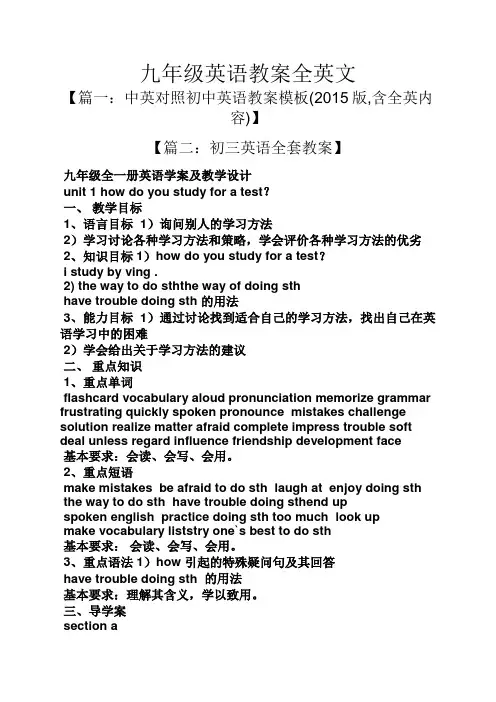
九年级英语教案全英文【篇一:中英对照初中英语教案模板(2015版,含全英内容)】【篇二:初三英语全套教案】九年级全一册英语学案及教学设计unit 1 how do you study for a test?一、教学目标1、语言目标 1)询问别人的学习方法2)学习讨论各种学习方法和策略,学会评价各种学习方法的优劣2、知识目标1)how do you study for a test?i study by ving .2) the way to do sththe way of doing sthhave trouble doing sth 的用法3、能力目标 1)通过讨论找到适合自己的学习方法,找出自己在英语学习中的困难2)学会给出关于学习方法的建议二、重点知识1、重点单词flashcard vocabulary aloud pronunciation memorize grammar frustrating quickly spoken pronounce mistakes challenge solution realize matter afraid complete impress trouble soft deal unless regard influence friendship development face基本要求:会读、会写、会用。
2、重点短语make mistakes be afraid to do sth laugh at enjoy doing sth the way to do sth have trouble doing sthend upspoken english practice doing sth too much look upmake vocabulary liststry one`s best to do sth基本要求:会读、会写、会用。
3、重点语法 1)how 引起的特殊疑问句及其回答have trouble doing sth 的用法基本要求:理解其含义,学以致用。
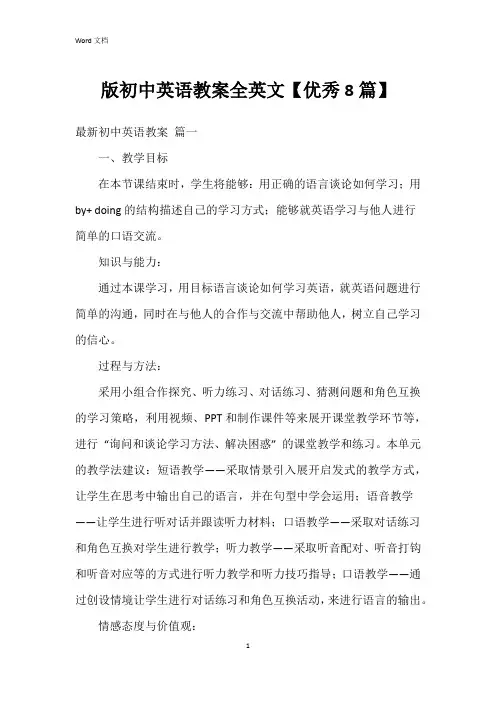
版初中英语教案全英文【优秀8篇】最新初中英语教案篇一一、教学目标在本节课结束时,学生将能够:用正确的语言谈论如何学习;用by+ doing的结构描述自己的学习方式;能够就英语学习与他人进行简单的口语交流。
知识与能力:通过本课学习,用目标语言谈论如何学习英语,就英语问题进行简单的沟通,同时在与他人的合作与交流中帮助他人,树立自己学习的信心。
过程与方法:采用小组合作探究、听力练习、对话练习、猜测问题和角色互换的学习策略,利用视频、PPT和制作课件等来展开课堂教学环节等,进行“询问和谈论学习方法、解决困惑” 的课堂教学和练习。
本单元的教学法建议:短语教学——采取情景引入展开启发式的教学方式,让学生在思考中输出自己的语言,并在句型中学会运用;语音教学——让学生进行听对话并跟读听力材料;口语教学——采取对话练习和角色互换对学生进行教学;听力教学——采取听音配对、听音打钩和听音对应等的方式进行听力教学和听力技巧指导;口语教学——通过创设情境让学生进行对话练习和角色互换活动,来进行语言的输出。
情感态度与价值观:通过参与课题教学活动,增进同学之间的了解和友情,并在交流中了解英语学习的方法,建立学习英语的自信。
二、教学重难点教学重点:学习并掌握How do you study...? I study...by ....等相关句型和词汇。
学习并掌握用by + doing 结构表达方式方法。
教学难点:学习并用丰富的语言描述英语学习的方式和方法。
三、教学策略短语教学——采取视频引入话题然后进行启发式教学,并在对话中运用;语音教学——让学生跟读听力材料进行模仿式操练;口语教学——采取pair work 和Role- play问答式的口语交际活动或小组活动互相操练;听力教学——采取采取听音配对、听音打钩和听音对应等方式语法教学——通过模仿听力材料进行对话练习,在教师的纠正中培养正确的by + doing 的结构意识。
初中英语公开课教案篇二课前准备教师:准备游戏时所用的图片(食物、蔬菜、动物)。
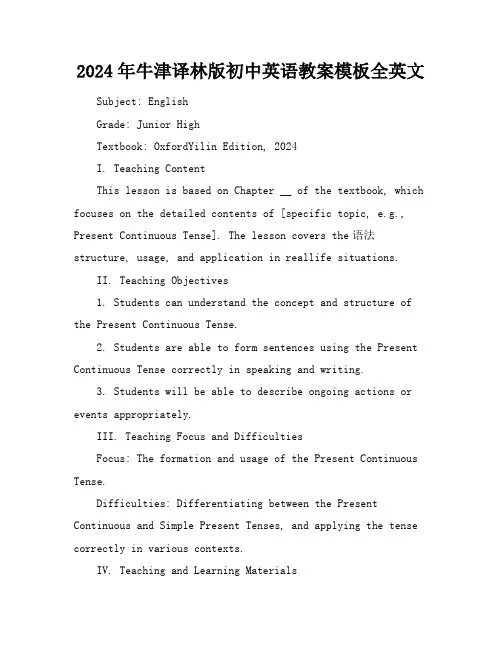
2024年牛津译林版初中英语教案模板全英文Subject: EnglishGrade: Junior HighTextbook: OxfordYilin Edition, 2024I. Teaching ContentThis lesson is based on Chapter __ of the textbook, which focuses on the detailed contents of [specific topic, e.g., Present Continuous Tense]. The lesson covers the语法structure, usage, and application in reallife situations.II. Teaching Objectives1. Students can understand the concept and structure of the Present Continuous Tense.2. Students are able to form sentences using the Present Continuous Tense correctly in speaking and writing.3. Students will be able to describe ongoing actions or events appropriately.III. Teaching Focus and DifficultiesFocus: The formation and usage of the Present Continuous Tense.Difficulties: Differentiating between the Present Continuous and Simple Present Tenses, and applying the tense correctly in various contexts.IV. Teaching and Learning Materials1. Textbook2. Whiteboard/Blackboard3. Visual aids (pictures, charts)4. Handouts with practice exercisesV. Teaching Process1. Introduction (5 minutes)Engage students with a practical scenario, e.g., showing pictures of people engaged in different ongoing activities.Elicit from students what they observe and encourage them to describe the actions using present tense.2. Presentation (15 minutes)Present the grammar rule of the Present Continuous Tense, emphasizing the usage of "am/is/are + verbing."Provide examples on the board, explaining the structure and function of the tense.Conduct choral repetition and individual practice to ensure understanding.3. Guided Practice (15 minutes)Give out handouts with guided exercises for students to practice forming sentences in Present Continuous Tense.Walk around the classroom to provide assistance and feedback.4. Interactive Activity (10 minutes)Organize an "Interview" activity where students ask and answer questions about ongoing actions using the Present Continuous Tense.5. Explanation and Clarification (10 minutes)Provide additional examples and practice to reinforce learning.6. Independent Practice (15 minutes)Assign a worksheet with various exercises, including fillintheblanks, sentence transformations, and writing prompts.Allow students to work individually while providing help to those in need.7. Review and Consolidation (10 minutes)Recap the main points of the lesson with students' participation.Review answers to the independent practice worksheet as a whole class.VI. Blackboard DesignThe board will be divided into sections:1. Title: Present Continuous Tense2. Grammar rules and examples3. Space for studentgenerated sentences4. Common errors and correctionsVII. Homework Design1. Write a short paragraph describing what your family members are doing right now.Example Answer: My brother is playing video games, my mother is cooking dinner, and my father is reading the newspaper.2. Create a dialogue between two friends meeting unexpectedly, using at least 10 sentences with the Present Continuous Tense.Answer Key will be provided with correct usage of the tense in the dialogue.VIII. Reflection and ExtensionReflect on the effectiveness of the practical scenario and interactive activities in engaging students.Consider modifications for future lessons to address any persisting difficulties.Provide extension activities for students seeking additional challenges, such as writing a story using the Present Continuous Tense or conducting an interview with a family member about their current activities.重点和难点解析:1. 教学难点与重点的明确;2. 教学过程中的实践情景引入;3. 教学过程中的互动活动设计;4. 板书设计;5. 作业设计;6. 课后反思及拓展延伸。
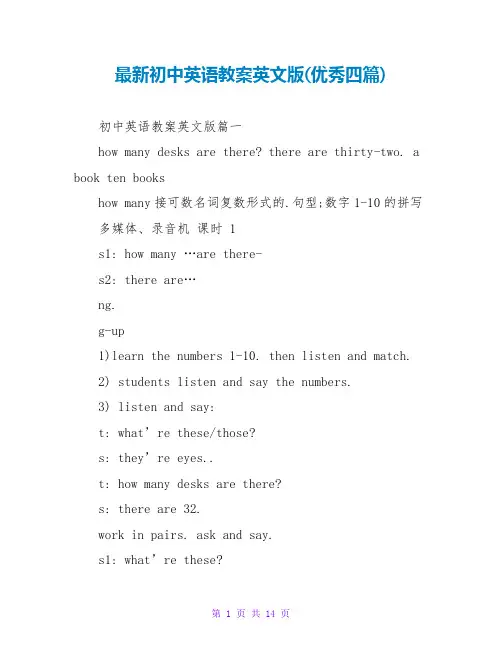
最新初中英语教案英文版(优秀四篇)初中英语教案英文版篇一how many desks are there? there are thirty-two. a book ten bookshow many接可数名词复数形式的.句型;数字1-10的拼写多媒体、录音机课时 1s1: how many …are there-s2: there are…ng.g-up1)learn the numbers 1-10. then listen and match.2) students listen and say the numbers.3) listen and say:t: what’re these/those?s: they’re eyes..t: how many desks are there?s: there are 32.work in pairs. ask and say.s1: what’re these?1) write the numbers.2) look at the pictures and write the phrases.derkwork book.个人修改初中英语教案英文版篇二starter module3 unit1 课型 listeningandspeaking学习询问颜色句型what colour are …? they are red. how do you spell “red”? r-e-d.颜色词汇的拼写记忆多媒体、录音机课时 1ng.g-up1)look and learn theword:apple,banana,flower,tree,bird,cat2) look at the pictures and the colour words.3) listen and say:t: what colour are they?t: how do you spell “red”?s: r-e-d..work in pairs. ask and say.s1: what colour are they?s2: they’re….s1: how do you spell it?s2: …se1) read and match.2) look at the pictures and write the sentences.derkwork book.初中英语教案英文版篇三sectiona 1a-2d一、教学目的〔一〕知识与技能:1. 学习并掌握1a-2d的单词和短语(1) rainstorm, alarm, begin ,heavily ,suddenly, strange;(2)go off, pick up, take a shower, make sure;2. 掌握并运用句型(1)what were you doing yesterday at the time of the rainstorm?(2)when you called, i was having a shower.(3)so while you were sleeping, i called jenny and she helped me.(4)what were you doing when the rainstorm came?3.掌握过去进展时态的构造和功能,学会使用when和while从句。
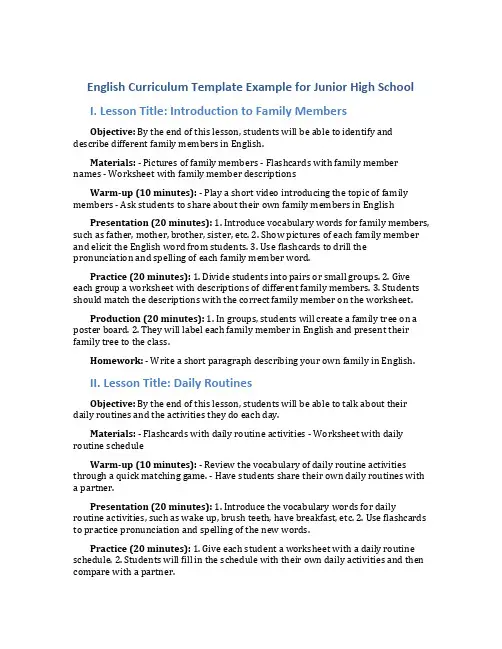
English Curriculum Template Example for Junior High SchoolI. Lesson Title: Introduction to Family MembersObjective: By the end of this lesson, students will be able to identify and describe different family members in English.Materials: - Pictures of family members - Flashcards with family member names - Worksheet with family member descriptionsWarm-up (10 minutes): - Play a short video introducing the topic of family members - Ask students to share about their own family members in English Presentation (20 minutes): 1. Introduce vocabulary words for family members, such as father, mother, brother, sister, etc. 2. Show pictures of each family member and elicit the English word from students. 3. Use flashcards to drill the pronunciation and spelling of each family member word.Practice (20 minutes): 1. Divide students into pairs or small groups. 2. Give each group a worksheet with descriptions of different family members. 3. Students should match the descriptions with the correct family member on the worksheet.Production (20 minutes): 1. In groups, students will create a family tree on a poster board. 2. They will label each family member in English and present their family tree to the class.Homework: - Write a short paragraph describing your own family in English.II. Lesson Title: Daily RoutinesObjective: By the end of this lesson, students will be able to talk about their daily routines and the activities they do each day.Materials: - Flashcards with daily routine activities - Worksheet with daily routine scheduleWarm-up (10 minutes): - Review the vocabulary of daily routine activities through a quick matching game. - Have students share their own daily routines with a partner.Presentation (20 minutes): 1. Introduce the vocabulary words for daily routine activities, such as wake up, brush teeth, have breakfast, etc. 2. Use flashcards to practice pronunciation and spelling of the new words.Practice (20 minutes): 1. Give each student a worksheet with a daily routine schedule. 2. Students will fill in the schedule with their own daily activities and then compare with a partner.Production (20 minutes): 1. In pairs, students will create a dialogue about their daily routines. 2. They will perform their dialogue in front of the class.Homework: - Write a diary entry about your day, including all your daily routines in English.By following this lesson plan template, teachers can effectively introduce and practice English vocabulary and grammar concepts with their junior high school students in an engaging and interactive manner.。
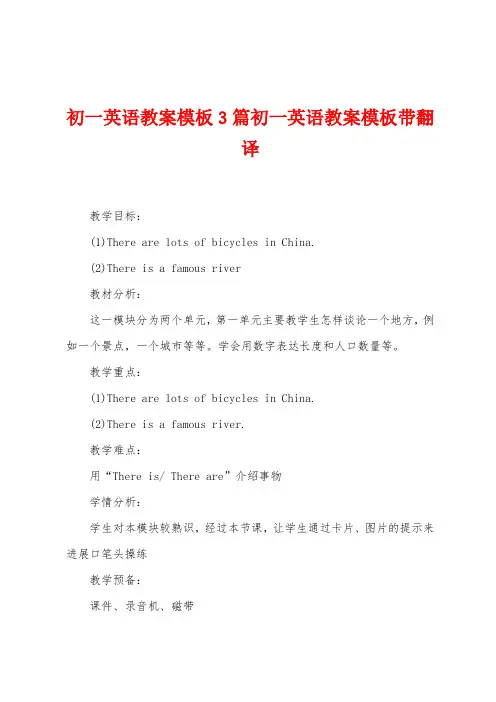
初一英语教案模板3篇初一英语教案模板带翻译教学目标:(1)There are lots of bicycles in China.(2)There is a famous river教材分析:这一模块分为两个单元,第一单元主要教学生怎样谈论一个地方,例如一个景点,一个城市等等。
学会用数字表达长度和人口数量等。
教学重点:(1)There are lots of bicycles in China.(2)There is a famous river.教学难点:用“There is/ There are”介绍事物学情分析:学生对本模块较熟识,经过本节课,让学生通过卡片、图片的提示来进展口笔头操练教学预备:课件、录音机、磁带教学过程:一、嬉戏热身随音乐传递物品,音乐停该同学用there be 句型说句子二、导入让学生先观看图片,猜猜都是中国的什么地三、课文教学1、播放录音,让学生给所听到的录音图片排序。
2、接着让学生跟读3、试着让学生用自己的语言描述图片上的内容。
4、现在可以变换练习方式。
请学生两人一组.向对方介绍六张明信片中自己最喜爱的一张。
假如有必要,可以再放一遍录音,请学生逐句跟读,并试着抓住每张明信片最主要的特征.然后再向同伴叙述。
鼓舞学生依据图片进展更多描述,或是把自己对该事物的了解添加到描述中去。
5、重音的学习:请学生听SB unit 2活动3的录音,之后让学生试着跟读一遍。
要求他们留意重读的地方。
请学生把书翻到SB unit 2活动3,认真看书上的句子以及每句话中用黑体标出的地方,比拟一下自己刚刚跟读时重读的位置与书上的标注是否全都。
教师再放录音,学生边听边看书,仔细体会。
四、应用现在学生衣服上的图案很丰富。
教师可让一个学生站在黑板前,让其他学生用“There 胡屯镇联合校集备活页五、学习歌曲完成SB unit 2活动4,请学生观赏并学习一首歌曲。
放录音前,请学生们先试着通过文字和图片猜想歌曲的内容。
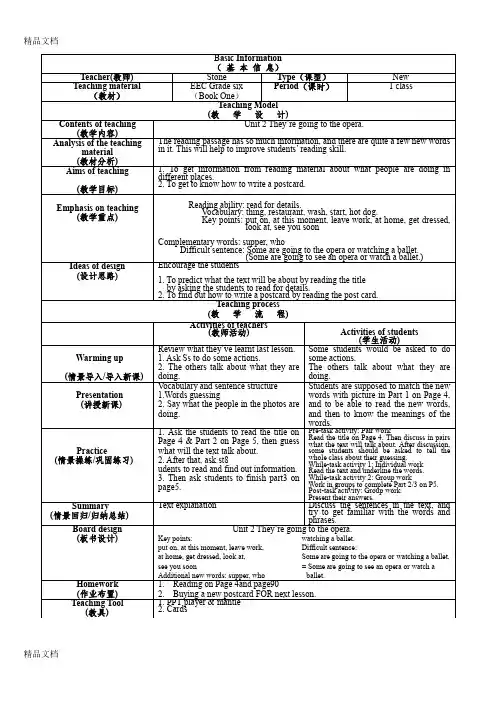
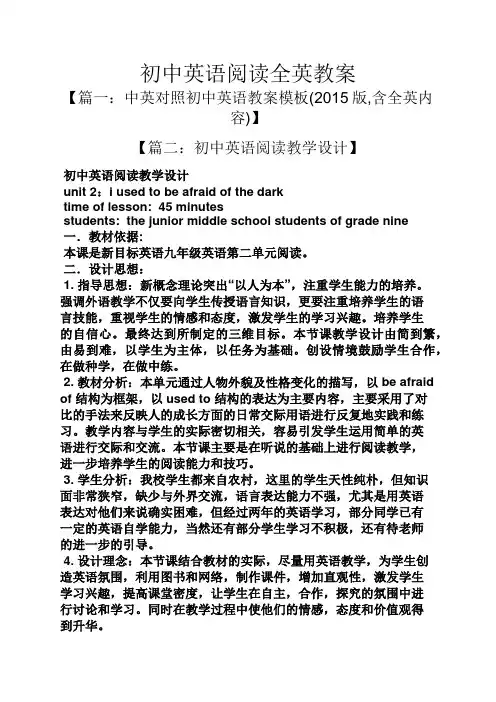
初中英语阅读全英教案【篇一:中英对照初中英语教案模板(2015版,含全英内容)】【篇二:初中英语阅读教学设计】初中英语阅读教学设计unit 2:i used to be afraid of the darktime of lesson: 45 minutesstudents: the junior middle school students of grade nine 一.教材依据:本课是新目标英语九年级英语第二单元阅读。
二.设计思想:1. 指导思想:新概念理论突出“以人为本”,注重学生能力的培养。
强调外语教学不仅要向学生传授语言知识,更要注重培养学生的语言技能,重视学生的情感和态度,激发学生的学习兴趣。
培养学生的自信心。
最终达到所制定的三维目标。
本节课教学设计由简到繁,由易到难,以学生为主体,以任务为基础。
创设情境鼓励学生合作,在做种学,在做中练。
2. 教材分析:本单元通过人物外貌及性格变化的描写,以be afraid of 结构为框架,以used to 结构的表达为主要内容,主要采用了对比的手法来反映人的成长方面的日常交际用语进行反复地实践和练习。
教学内容与学生的实际密切相关,容易引发学生运用简单的英语进行交际和交流。
本节课主要是在听说的基础上进行阅读教学,进一步培养学生的阅读能力和技巧。
3. 学生分析:我校学生都来自农村,这里的学生天性纯朴,但知识面非常狭窄,缺少与外界交流,语言表达能力不强,尤其是用英语表达对他们来说确实困难,但经过两年的英语学习,部分同学已有一定的英语自学能力,当然还有部分学生学习不积极,还有待老师的进一步的引导。
4. 设计理念:本节课结合教材的实际,尽量用英语教学,为学生创造英语氛围,利用图书和网络,制作课件,增加直观性,激发学生学习兴趣,提高课堂密度,让学生在自主,合作,探究的氛围中进行讨论和学习。
同时在教学过程中使他们的情感,态度和价值观得到升华。
三.教学目标:1.知识与技能:(1)let students master new vocabulary, phrases and sentences of the lesson.(2)eight percent students are able to use the vocabulary , phrases and sentences to make sentences and simple retelling.(3)sixty percent students are able to use the vocabulary , phrases and sentences to retell the passage and clarify his views.2. 过程与方法:(1) multimedia aided teaching method(2) communicative approach(3) build-up the reading ability(4) learning by doing and doing by learning3. 情感,态度与价值观:through appreciating the music, enhance students cultural accomplishment, inspire students to thank their parents and love their parents, pay close attention to the people around.四.教学重点:1. the structure “use to”.2. new vocabulary, phrases and sentences3. reading ability五.教学难点:make the students get the information from the skimming and scanning六.教学准备:multi-media recorder and library books.七.教学过程:step1. pre—reading1. get the students to describe their parents.t: parents are the most familiar and loved person to you. can you give a brief description of them? you can describe what they used to be like and they are like now. (students may describe their age, appearance, personality and hobbies they used to be and now.ss: show the results of the collections.a) 看着孩子一天天长大,知识一天天丰富,仿佛农民看见自己的庄稼日渐成熟,母亲的心里是充满幸福、喜悦的。
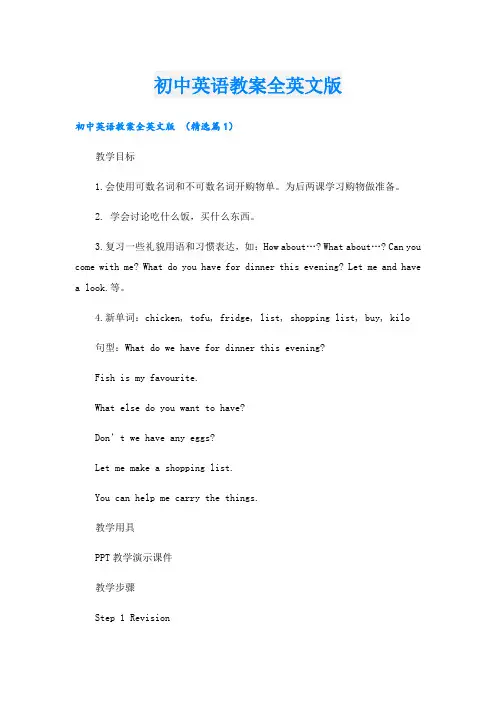
初中英语教案全英文版初中英语教案全英文版(精选篇1)教学目标1.会使用可数名词和不可数名词开购物单。
为后两课学习购物做准备。
2. 学会讨论吃什么饭,买什么东西。
3.复习一些礼貌用语和习惯表达,如:How about…? What about…? Can you come with me? What do you have for dinner this evening? Let me and havea look.等。
4.新单词:chicken, tofu, fridge, list, shopping list, buy, kilo句型:What do we have for dinner this evening?Fish is my favourite.What else do you want to have?Don’t we have any eggs?Let me make a shopping list.You can help me carry the things.教学用具PPT教学演示课件教学步骤Step 1 Revision[课件展示]教师在课堂上提问题,引导学生回答 What do you have for breakfast today? Shall we go and buy something to eat? What’s in the pictures? Let me see. What do we have for lunch today? How about…? What about…? What else do you want to have? Can you go and buy the things? Let’s go.等。
老师也可以同样的方式提问全班同学。
教师展示课件中Revision的食物图片,复习一些食品的名称。
Step 2 Presentation[课件展示]教师在复习食品名称基础上,引出购物的话题。
Title: [Subject of the Lesson]Grade Level: [Grade Level]Subject: EnglishDuration: [Duration of the Lesson, e.g., 45 minutes]Objective:- To [Main Objective of the Lesson, e.g., improve speaking skills, enhance vocabulary, or understand a specific topic].- To [Secondary Objective, if applicable].Materials Needed:- Textbook and workbook for the grade level.- Whiteboard or blackboard and markers.- Projector and computer (if available).- Handouts or worksheets.- Flashcards or pictures (for vocabulary).- Audio or video materials (optional).- Timer or clock.Preparation:1. Familiarize yourself with the lesson content and ensure you understand the vocabulary and grammar points.2. Prepare any handouts or worksheets in advance.3. Organize the classroom and materials.4. Prepare for any interactive or group activities.5. Set up the audio-visual equipment if necessary.Warm-up (5 minutes)1. Activity: Quickfire Questions- Ask students to answer a series of quick questions related to the theme of the lesson to stimulate their thinking and engage them in English.- Example questions: "What is your favorite animal?" "Where do you like to go on vacation?"2. Purpose: To review previous learning and get students thinking in English.---Introduction (5 minutes)1. Activity: Brainstorming- Write the main topic of the lesson on the board and ask students to brainstorm related ideas.- Example: For a lesson on "Hobbies," ask students to think of different hobbies they know.2. Purpose: To introduce the topic and get students thinking about the lesson content.---Main Content (20 minutes)1. Activity: Reading Comprehension- Read a passage from the textbook or hand out a worksheet with a reading passage.- Have students read silently and then discuss the main ideas with a partner.2. Purpose: To develop reading skills and understanding of the text.3. Activity: Vocabulary Building- Introduce new vocabulary related to the lesson theme.- Use flashcards or pictures to help students visualize and remember the words.- Practice using the new vocabulary in sentences.4. Purpose: To expand students' vocabulary and improve their ability to express themselves in English.5. Activity: Grammar Practice- Introduce and explain a new grammar point relevant to the lesson.- Provide examples and have students practice the grammar point in sentences or short texts.6. Purpose: To enhance students' grammatical knowledge and usage.---Practice (15 minutes)1. Activity: Pair Work- Assign a task that requires students to work in pairs, such as creating a dialogue based on the reading passage or discussing the vocabulary.2. Purpose: To encourage communication and reinforce learning through collaboration.3. Activity: Group Activity- Divide the class into small groups and give each group a different task related to the lesson, such as creating a poster or a presentation.4. Purpose: To promote teamwork and critical thinking.---Conclusion (5 minutes)1. Activity: Summarization- Ask students to summarize the main points of the lesson and what they have learned.- Example: "What are the main hobbies we discussed today?" "What new vocabulary did we learn?"2. Purpose: To reinforce learning and ensure students understand the key concepts.3. Activity: Homework Assignment- Assign homework that reinforces the lesson content, such as writing a short essay or completing a workbook exercise.4. Purpose: To extend learning beyond the classroom.---Assessment:- Evaluate students'。
Subject: EnglishGrade Level: Junior High SchoolDuration: 45 minutesLesson Objective:To help students improve their understanding and usage of [specific language point or skill], and to enhance their overall English proficiency.Materials Needed:- Whiteboard or blackboard- Markers or chalk- Handouts or worksheets related to the lesson topic- Projector or computer with presentation software (optional)- Flashcards (optional)- Audio/visual aids (videos, songs, etc.) (optional)Preparation:1. Review the previous lesson's content to ensure students have a solid foundation.2. Prepare handouts or worksheets that reinforce the lesson's objectives.3. Create or select appropriate audio/visual aids to support the lesson.4. Prepare flashcards if needed for vocabulary practice.5. Set up the classroom environment for an interactive and engaging learning experience.Warm-up (5 minutes):1. Greet students and ask them how they are doing.2. Conduct a quick review of the previous lesson using a simplequestion-and-answer session.3. Engage students in a short activity that relates to the lesson topic, such as a brief discussion or a game.Main Activity (30 minutes):1. Introduction:- Introduce the new topic or language point with a brief explanation.- Use visuals or examples to clarify any difficult concepts.2. Vocabulary Practice:- Present new vocabulary items using flashcards or a Powerpoint presentation.- Have students practice using the new words in sentences or through a vocabulary game.3. Grammar Focus:- Explain the grammar rule or structure that corresponds to the lesson's objective.- Provide examples and exercises for students to practice the grammar in context.4. Reading Comprehension:- Read a passage aloud or distribute a handout with a reading passage.- Ask questions to check for understanding and encourage students to discuss the text.5. Writing Activity:- Assign a writing task that relates to the lesson topic, focusing on the language point or skill being taught.- Provide guidelines and a model to help students with their writing.6. Speaking Practice:- Engage students in a group activity or role-play that requires them to use the new language.- Encourage peer feedback and self-assessment.Conclusion (5 minutes):1. Summarize the main points of the lesson.2. Review any key vocabulary or grammar rules.3. Assign homework or an extension activity to reinforce learning.Homework Assignment:- Provide a clear, concise homework assignment that includes reading, writing, or speaking tasks.- Ensure that the homework is relevant to the lesson's objectives and provides students with an opportunity to practice what they learned.Assessment:- Observe students' participation and engagement during the lesson.- Assess students' understanding through in-class activities, quizzes, or homework assignments.- Provide constructive feedback to help students improve their language skills.Reflection:- At the end of the lesson, reflect on what worked well and what could be improved for future lessons.- Consider how the lesson objectives were met and whether the activities were appropriate for the students' needs.---This template can be adapted to fit various teaching styles and lesson topics. Remember to be flexible and responsive to the needs of your students, and to create a supportive and interactive learning environment.。
Subject: English Language ArtsGrade Level: 7th GradeLesson Title: "The Magic of Stories"Objective:- Students will be able to understand and summarize the main idea of a short story.- Students will practice reading comprehension skills through guided reading and group discussions.- Students will develop their ability to express opinions and justify their viewpoints in English.Duration: 90 minutesMaterials:- Textbook or story selection- Whiteboard and markers- Handouts with comprehension questions- Copies of the story for each student- Student response sheetsPreparation:- Select a short story that is appropriate for the grade level and is engaging for the students.- Prepare handouts with comprehension questions and vocabulary exercises.- Create a visual aid or poster related to the story to stimulate interest.Lesson Procedure:1. Introduction (10 minutes)- Greet the students and review the learning objectives for the lesson.- Introduce the story with a brief background or hook to capture the students' interest.- Display the visual aid or poster related to the story.2. Guided Reading (15 minutes)- Distribute copies of the story to the students.- Read the story aloud to the class, pausing to discuss key points and vocabulary.- Encourage students to follow along and ask questions as needed.3. Comprehension Check (15 minutes)- Hand out the comprehension questions to the students.- Allow students to work individually or in pairs to answer the questions.- Go over the answers as a class, discussing any misconceptions or difficulties.4. Group Discussion (20 minutes)- Divide the class into small groups.- Assign each group a specific section of the story to discuss and analyze.- Instruct the groups to identify the main idea, characters, setting, and conflict.- After a few minutes, bring the groups together for a whole-class discussion.- Encourage students to express their opinions and support their viewpoints with evidence from the text.5. Vocabulary Exercises (15 minutes)- Introduce new vocabulary words from the story.- Provide definitions and examples for each word.- Have students complete vocabulary exercises on the handouts, such as fill-in-the-blanks or matching exercises.6. Creative Writing (10 minutes)- Ask students to write a short paragraph or summary of the story, focusing on the main idea and key details.- Encourage students to use new vocabulary words in their writing.7. Conclusion (5 minutes)- Summarize the main points of the lesson and review the learning objectives.- Acknowledge the students' participation and contributions during the lesson.- Assign homework, such as reading a new short story or completing a related activity.Assessment:- Evaluate the students' understanding of the story through their answers to comprehension questions and participation in group discussions.- Assess the students' vocabulary acquisition through their completion of vocabulary exercises.- Monitor the students' writing skills through their creative writing assignments.Reflection:- After the lesson, reflect on the effectiveness of the teaching methods and activities.- Consider any adjustments that could be made to improve future lessons.- Reflect on the students' engagement and learning outcomes.。
初中英语教案纯英文翻译Introduction:This lesson aims to improve students' listening and speaking skills through role-playing activities. The target language for this lesson will be the use of past tense to talk about what happened in the past. The lesson is designed for middle school students and assumes that they have a basic understanding of English grammar and vocabulary.Objectives:1. To practice using past tense to describe past events.2. To improve listening and speaking skills through role-playing.3. To enhance students' ability to communicate effectively in English.Materials:1. Flashcards with pictures of different activities.2. Handout with a list of past tense verbs.3. Tape recorder and audio materials.Procedure:Step 1: warmer (5 minutes)The teacher will start the class with a warmer activity to get students engaged. The teacher will show flashcards with pictures of different activities (e.g., play soccer, read a book, go shopping) and ask students to name the activities in English. This will help students review and practice their English vocabulary.Step 2: introduction (10 minutes)The teacher will introduce the topic of the lesson by asking students questions about their past experiences (e.g., "What did you do last weekend?"). The teacher will model the use of past tense by answering the questions using the target language (e.g., "I played soccer with my friends last weekend").Step 3: group work (10 minutes)Students will be divided into groups of three or four. Each group will be given a handout with a list of past tense verbs and a list of pictures of different activities. The groups will have 5 minutes to match the verbs with the correct pictures and create a short dialogue using past tense to describe what happened in the past.Step 4: role-playing (15 minutes)Each group will have the opportunity to present their dialogue in front of the class. The other students will listen and ask questions to the presenting group. The teacher will encourage students to use past tense in their questions (e.g., "What did you do yesterday?").Step 5: listening activity (10 minutes)The teacher will play an audio material for the students, which will include a short story about a boy's past experiences. Students will be asked to listen carefully and answer some comprehension questions about the story. The questions will focus on the use of past tense in the story.Step 6: summary and conclusion (5 minutes)The teacher will summarize the main points of the lesson and reinforce the importance of using past tense to talk about past events. The teacher will also encourage students to practice their listening and speaking skills outside of the classroom by engaging in conversations with their peers.Assessment:The teacher will assess students' understanding and participation in the role-playing activities, as well as their ability to use past tense correctly in their dialogues. The teacher will also observe students' listening comprehension during the audio activity and provide feedback accordingly.。
初中英语教案全英文版Subject: EnglishGrade Level: 7th GradeDuration: 1 hourObjectives:At the end of the lesson, students will be able to:1. Describe the characteristics of different planets in our solar system.2. Identify the order of the planets in our solar system.3. Use past tense sentences to describe the formation of the solar system.4. Engage in a group activity to create a presentation about a planet of their choice. Materials:1. Whiteboard or blackboard2. Markers or chalk3. Handout with planet facts (optional)4. Access to a planetarium or virtual planetarium software5. Projector or smartboard for displaying visual aidsProcedure:1. Introduction (10 minutes)a. Begin the lesson by asking students if they have ever heard of the planets in our solar system.b. Allow students to share their knowledge and then provide a brief overview of the planets.c. Explain that today's lesson will focus on the characteristics of different planets and the order of the planets in our solar system.2. Lesson Presentation (20 minutes)a. Write the name of each planet in our solar system on the board in the order they appear from the sun.b. For each planet, list its characteristics (e.g., size, composition, atmosphere, and temperature) on the board.c. Explain that the solar system was formed approximately 4.6 billion years ago, and the planets have been evolving ever since.d. Provide a brief explanation of how the planets were formed and their order in the solar system.e. Use visual aids such as pictures or diagrams to help students understand the information.3. Group Activity (20 minutes)a. Divide students into small groups of 3-4 students each.b. Assign each group a planet to research and create a presentation about.c. Provide each group with a handout containing facts about the planets or allow them to research the information on their own.d. Instruct the groups to create a presentation using visuals, facts, and creative elements such as poems or songs if desired.e. Allow students to present their findings to the class, and encourage peer feedback and discussion.4. Conclusion (10 minutes)a. Summarize the key points discussed during the lesson, including the characteristics of different planets and the order of the planets in our solar system.b. Encourage students to share their thoughts on what they found most interesting or surprising about the planets.c. Assess student understanding by asking them to name the planets in order or describe the characteristics of a specific planet.Assessment:1. Observation of student participation during group activity.2. Assessment of student presentations and peer feedback.3. Exit ticket: Students will write down the name of a planet and list three characteristics of that planet.。
教学目标:1. 知识目标:学生能够掌握关于天气的表达方式,包括常见的天气词汇和表达天气变化的句型。
2. 能力目标:学生能够运用所学词汇和句型进行简单的对话,描述和询问天气情况。
3. 情感目标:通过学习天气相关的词汇和句型,激发学生对英语学习的兴趣,提高语言交际能力。
教学重点:1. 词汇:sunny, cloudy, rainy, windy, snowy, sunny day, rainy day, cloudy day等。
2. 句型:What's the weather like today? It'ssunny/rainy/cloudy/windy/snowy.教学难点:1. 词汇的正确拼写和使用。
2. 句型的正确运用和灵活转换。
教学准备:1. 教学课件或黑板。
2. 天气相关的图片或卡片。
3. 录音设备。
教学过程:一、导入(5分钟)1. 老师展示一些关于天气的图片或卡片,引导学生观察并说出对应的天气词汇。
2. 老师提问:What's the weather like today? 学生回答,并引导他们用正确的词汇描述天气。
二、新课讲授(20分钟)1. 老师通过课件或黑板,介绍天气相关的基本词汇,如sunny, cloudy, rainy, windy, snowy等。
2. 老师讲解并示范句型:What's the weather like today? It'ssunny/rainy/cloudy/windy/snowy.3. 学生跟读并模仿,老师纠正发音和语调。
三、巩固练习(15分钟)1. 老师组织学生进行小组活动,让学生用所学词汇和句型描述不同天气情况下的活动。
2. 学生互相提问,如:What's the weather like today? What will you do? 等。
3. 老师巡回指导,纠正学生的发音和语法错误。
四、课堂小结(5分钟)1. 老师带领学生回顾本节课所学内容,强调重点词汇和句型。